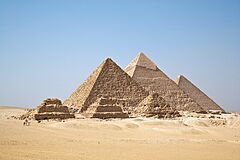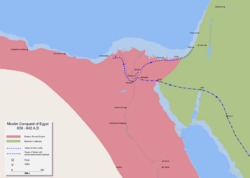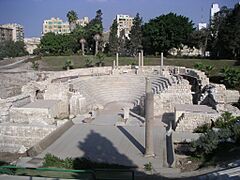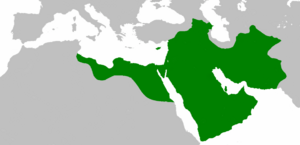Arab conquest of Egypt facts for kids
Quick facts for kids Arab conquest of Egypt |
|||||||||
|---|---|---|---|---|---|---|---|---|---|
| Part of the Arab–Byzantine wars | |||||||||
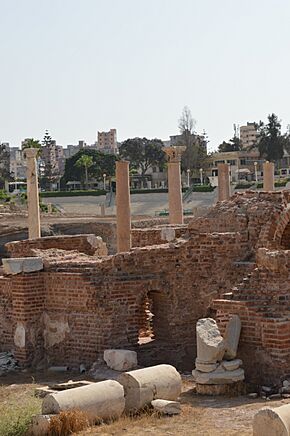 Roman Theater in the city of Alexandria, Egypt |
|||||||||
|
|||||||||
| Belligerents | |||||||||
| Rashidun Caliphate | |||||||||
| Commanders and leaders | |||||||||
|
|
||||||||
The Arab conquest of Egypt was a major event in history. It happened between 639 and 642 AD. An army led by Amr ibn al-As from the Rashidun Caliphate conquered Egypt. This ended nearly 700 years of Roman rule in Egypt. It also marked the end of about 1,000 years of Greco-Roman influence in the region.
Before the Arabs arrived, the Byzantine Empire (also known as the Eastern Roman Empire) had been weakened. Egypt had been taken over by the Sasanian Empire for ten years (618–629). Even though the Byzantine emperor Heraclius got it back, the empire was tired. The Caliphate took advantage of this weakness to invade Egypt.
By the mid-630s, the Romans had already lost important lands like the Levant to the Caliphate. Losing Egypt, a rich province, and seeing their armies defeated, made the Byzantine Empire much weaker. This led to them losing even more land in the future.
Contents
Why the Arabs Invaded Egypt
In 640, Heraclius was the Byzantine emperor. Cyrus of Alexandria was both the governor of Egypt and the head of the church there. Theodore was the main general of the Byzantine army in Egypt.
After the death of Muhammad in 632 AD, the Arab armies of the Rashidun Caliphate began to expand. They moved towards both the Persian and Byzantine Empires. Neither of these powerful empires was ready for the Arabs' fast expansion. They didn't realize how strong Islam and its followers had become.
After winning big battles against the Byzantines at Yarmuk (636) and the Persians at Qadisiyah (637), the Arab generals looked towards the rich lands of Byzantine Africa. After the Siege of Jerusalem, it was Amr ibn al-As who suggested invading Egypt to the Caliph, Umar ibn al-Khattab. Amr knew Egypt was wealthy because he had visited it as a merchant. He told the Caliph that conquering Egypt would make the Muslims much stronger. He said it was the richest land and the weakest in terms of fighting.
Caliph Umar was convinced by Amr to go ahead with the invasion. However, he later had second thoughts. But it was too late to stop Amr.
The Rashidun Invasion Begins
Crossing into Egypt
In December 639, Amr ibn al-As set off for Egypt with 4,000 soldiers. Most of them were from the Arab tribe of 'Ak. Some Roman and Persian people who had become Muslim also joined them. The Muslim leader, Caliph Umar, thought it was risky to try and conquer Egypt with so few soldiers. He sent a letter to Amr, telling him to come back.
However, the letter had a special rule: if Amr was already in Egypt when he received it, he could continue. The messenger reached Amr at Rafah, just before the Egyptian border. Guessing what the letter might say, Amr told his army to march faster. He waited until they had crossed into Egypt and stopped for the night at Shajratein, near El Arish. Only then did he open and read the letter. Since they were already on Egyptian soil, they decided to keep going.
When Caliph Umar heard this, he decided to send more soldiers to Egypt later. On Eid al-Adha, the Muslim army marched from Shajratein to El Arish. This was a small town with no soldiers defending it. The town surrendered without a fight.
Taking Pelusium and Belbeis
In December 639 or early January 640, the Muslim army reached Pelusium. This was a fort city, seen as the eastern entrance to Egypt. The siege of Pelusium lasted for two months. In February 640, a group of Muslim soldiers successfully captured the fort and the city.
The Muslims were helped by local Sinai Bedouins who joined their army. The easy fall of Pelusium and the lack of Roman help during the siege are sometimes blamed on Cyrus of Alexandria, who was the Greek Patriarch of Alexandria.
After Pelusium, the Muslims marched to Belbeis, about 65 km (40 miles) from Memphis. They surrounded the city. Belbeis was the first place where the Byzantines showed some real resistance. Two Christian monks, along with Cyrus of Alexandria and the Roman general Aretion, came out to talk with Amr ibn al-As. Amr gave them three choices: become Muslim, pay a special tax (called jizya), or fight. They asked for five days to think about it.
After five days, the monks and the general chose to fight, going against Cyrus's wish to surrender. Cyrus left for the Babylon Fortress. The battle ended with a Muslim victory. General Aretion was killed. The siege continued until Belbeis fell around the end of March 640.
The Siege of Babylon Fortress
Amr had thought Egypt would be easy to conquer, but he was wrong. Even smaller towns like Pelusium and Belbeis had fought hard. Babylon, near modern-day Cairo, was a much bigger and more important city. The Muslims arrived there in May 640.
Babylon was a very strong city. General Theodore had prepared it for a long siege. It had a deep ditch outside and a large army defending the walls. The fort itself was huge, about 18 meters (59 feet) high with walls over 2 meters (6.5 feet) thick. It had many towers and strong points, defended by about 4,000 soldiers. Early Muslim records say the Byzantine force was six times larger than the Muslim army. For two months, the fighting continued, but the Byzantines pushed back every Muslim attack.
Realizing Babylon was too strong to take easily, Amr sent some soldiers to raid the city of Faiyum. The Byzantines had protected the roads to Faiyum and strengthened their army in a nearby town. When the Muslims couldn't take Faiyum, they went to the Western Desert and took cattle and animals. They then attacked a town called Bahnasa, which they captured.
More Soldiers Arrive
In July, Amr asked Caliph Umar for more soldiers. Even before the letter reached him, Umar had already sent 4,000 experienced soldiers from the Syrian campaigns. But even with these, Amr was still struggling. So, in August, Umar sent another 4,000 elite soldiers. Zubayr ibn al-Awwam, a famous warrior, was put in charge of this new army.
These reinforcements arrived at Babylon in September 640. This brought the total Muslim force to about 12,000 soldiers. A Christian soldier, seeing how small the Muslim army was, wondered how they could fight against the Emperor's army. Another soldier replied that the Arabs would either win or die fighting.
Battle of Heliopolis
When Zubayr arrived, he told Amr that the city of Heliopolis was nearby. Soldiers from Heliopolis could attack the Muslims while they were fighting at Babylon. To remove this danger, Amr took about half of his men to Heliopolis.
The Muslim army reached Heliopolis, 15 km (10 miles) from Babylon, in July 640. This city was famous for its ancient temples and learning centers. There was a risk that soldiers from Heliopolis could attack the Muslims from the side while they were busy fighting at Babylon.
There was a small cavalry fight. It didn't decide the battle, but the Muslims took control of a fort. The defeated Byzantine soldiers went back to either Babylon or another fort called Nikiû. Zubayr and some of his best soldiers climbed the city wall of Heliopolis where it wasn't guarded. They surprised the guards and opened the gates for the rest of the army. After taking Heliopolis, Amr returned to Babylon.
Taking Fayoum and Babylon
When the governor of Fayoum heard about the Muslim victory at Heliopolis, he and his soldiers ran away. They didn't tell the people of Fayoum that they were leaving. When Amr found out, he sent troops across the Nile River. They took over the entire province of Fayoum with almost no fighting. The people of Fayoum were enslaved, and the city was looted.
Amr and Theodore, the Byzantine general, met to talk, but the talks didn't go anywhere. Then, on the night of December 20, a group of brave Muslim warriors led by Zubayr climbed the wall of Babylon. They killed the guards and opened the gates for the Muslim army. The city was captured the next morning. However, Theodore and his army managed to escape to an island in the Nile called Rauda, where they continued to fight.
Theodore gathered an army in the Nile Delta and put two generals in charge of defending Samannud. Amr went north to fight this army. The two generals in Samannud refused to fight, but Theodore fought Amr there and defeated him, causing many losses for the Muslims. The Muslims couldn't damage any cities in the Nile Delta and went back to Babylon. But Theodore couldn't take Babylon back.
The final Muslim attack on Babylon happened on Good Friday, April 6, 641. By Easter Monday, the Roman soldiers had left and were marching to Nikiû. The Romans were given a few days to leave so they could celebrate Easter. The Siege of Babylon had lasted seven months.
Surrender of Thebaid (Southeastern Egypt)
On December 22, Cyrus of Alexandria made a deal with the Muslims. He agreed that the Muslims would rule all of Egypt, including Thebaid (southeastern Egypt). He also agreed to pay a tax of 2 dinars per adult male. This treaty needed the approval of Emperor Heraclius. Cyrus promised that even if the emperor said no, he and the Egyptians would still follow the terms.
When Emperor Heraclius heard about this, he was very angry. He sent Cyrus a letter full of insults, calling him a coward. He asked how 100,000 Romans could be defeated by 12,000 "barbarians."
March to Alexandria
The Byzantine commanders knew that Alexandria was the Muslims' next target. They tried to stop the Muslims by attacking them along the way. In February 641, Amr set off for Alexandria from Babylon. He met defending armies all along the route. On the third day, the Muslim advance group met a Byzantine group at Tarnut. The Byzantines didn't cause many losses but delayed the Muslims for a whole day.
The Muslims continued their march. They reached Kebrias of Abadja, where a Byzantine general named Domentianus and his soldiers were. He cowardly fled the city in a small boat, leaving his soldiers behind. When the Arabs arrived, the soldiers threw their weapons into the water, hoping to be spared. But they were all killed. The Muslims then passed by Sais and killed the family of Theodore, the Byzantine general, who were there.
The Muslims continued fighting small battles and pushing back Byzantine forces. They finally reached Kirayun, about 20 km (12 miles) from Alexandria. Here, a Byzantine force of about 20,000 soldiers blocked their way. The fighting lasted for ten days. On the tenth day, the Muslims launched a strong attack, forcing the Byzantines to retreat to Alexandria. With the path clear, the Muslims reached the outskirts of Alexandria in March.
Theodore and Cyrus in Constantinople
Emperor Heraclius died in February 641. His two sons, Constantine III and Heraclonas, became co-emperors. Constantine, following his father's wishes, called Cyrus and Theodore to Constantinople to talk about the invasion. Cyrus wanted to surrender to the Muslims, but Theodore wanted to keep fighting and hoped the Emperor would send more soldiers to Egypt.
Constantine was preparing a fleet to send to Egypt, but he died after just 100 days as emperor. Heraclonas became the sole emperor, and his mother, Martina, took full control. She gave Cyrus permission to make peace with the Arabs at any cost. She also sent him more soldiers and a new general. After Theodore and Cyrus left for Egypt with reinforcements, Martina was removed from power. Theodore was happy about this and secretly tried to sail away from Cyrus. But he couldn't. They both returned to Alexandria on September 14, 641.
Meanwhile in Egypt, the Muslims had captured Babylon and Nikiu. The Muslims had also started their Siege of Alexandria.
Conquest of Alexandria
When Theodore returned to Alexandria, he removed Domentianus as the military commander and replaced him with Menas. Menas was a non-Chalcedonian Copt and popular with the army.
Cyrus then went to Babylon to negotiate with Amr. They agreed on a treaty with these terms:
- Everyone under the treaty would pay a fixed tax.
- There would be a ceasefire for about eleven months, ending on September 28, 642.
- During the ceasefire, the Arab forces would stay in their positions and not attack Alexandria. The Roman forces would also stop fighting.
- The soldiers in Alexandria could leave by sea, taking their belongings. Roman soldiers leaving by land would pay a monthly tax.
- No Roman army would try to take Egypt back.
- The Muslims would not take over churches or interfere with Christians.
- Jews could stay in Alexandria.
- The Romans would give 150 military and 50 civilian hostages to ensure the treaty was followed.
Cyrus returned to Alexandria and told Theodore and Constantine about this treaty. He convinced them it was necessary. They reported it to Emperor Heraclonas, who approved it. The local people were not told until an Arab army came to Alexandria to collect the tax. When they realized what had happened, an angry crowd tried to stone Cyrus. But he told them he made the treaty to save them and their children, which calmed them down. The first tax payment was made on December 10, 641, sealing Alexandria's surrender.
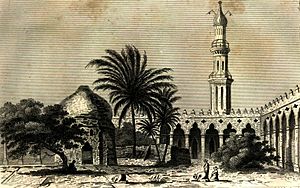
After the siege, Cyrus tried to let Egyptians who had fled to Alexandria during the war return home, but Amr didn't allow it. Amr began building his new capital, Fustat, just outside Babylon. Byzantine governors either became Muslim to keep their jobs or were replaced by Muslims. Amr and the Muslim governors made Christians work for them. They also made them dig a canal from the Nile to the Red Sea.
According to some sources, Amr broke parts of the treaty he made with Cyrus. Cyrus became sad and died on March 21, 642. Theodore was made governor of Egypt after Cyrus's death. He arranged for the Byzantine soldiers to leave Alexandria. On September 17, 642, Theodore left Egypt by ship with the last Roman troops. On September 29, the ceasefire ended. Amr marched his Arab army into Alexandria. This was the end of Roman Egypt.
Invasion of Nubia
In the summer of 642, Amr ibn al-As sent an army to the Christian kingdom of Nubia, south of Egypt. This was led by his cousin, 'Uqbah ibn Nafi. It was meant to show the Nubians that new rulers had arrived in Egypt. 'Uqbah ibn Nafi later became famous for conquering North Africa.
In Nubia, there were no big battles, only small fights. The Nubians were skilled archers. They shot so many arrows that 250 Muslim soldiers lost an eye. The Nubian cavalry was very fast. They would attack quickly and then disappear before the Muslims could fight back. These hit-and-run attacks hurt the Muslim army. 'Uqbah reported this to Amr, who ordered him to leave Nubia. A treaty was later made with the Nubians in 651–652. This secured the southern border of Muslim rule in Egypt.
Byzantine Counterattack
In 645, the new Byzantine Emperor Constans II wanted to take Egypt back. He sent a large fleet to Alexandria. These troops, led by Manuel, surprised the small Arab army and took the city in late 645. This meant Alexandria was temporarily back under Byzantine control.
Amr, who might have been in Mecca at the time, was quickly called back to lead the Arab forces in Egypt. When he returned, he fought the Byzantines at a small town called Nikiou. The Arab army had about 15,000 soldiers, while the Byzantine force was smaller. The Arabs won, and the Byzantine soldiers retreated in a mess back to Alexandria.
Even though the Byzantines closed the gates against the chasing Arabs, Alexandria eventually fell to the Arabs that summer. This defeat was the last time the Byzantine Empire tried to take back Egypt for about 500 years.
Egypt Under Muslim Rule
When Amr took Alexandria, the Roman governor, Cyrus, had sent the Coptic patriarch, Benjamin, away. After Amr captured Alexandria, a Coptic leader convinced him to invite Benjamin back. When Benjamin returned, the governor told him to take charge of the Coptic Church again. Benjamin helped restore the monasteries in the Wadi Natrun, which had been damaged. Four of them are still working monasteries today.
Benjamin worked with the Egyptian people. He even prayed for Amr's success against other Christians. Benjamin lived for almost twenty more years after Egypt fell to the Muslims, dying in 661. He is still honored as a saint. He played a big part in the survival of the Coptic Church.
Historians say that the conquest of Egypt was one of the fastest and most complete Muslim conquests. Within two years, the country was entirely under Arab rule. Even more remarkably, it has stayed under Muslim rule ever since.
Some sources say that the Arabs damaged the country, burned forts, looted areas, and killed many monks and nuns. However, others say that Amr collected taxes fairly and did not harm churches or Christians.
Uqba ibn Nafi later used Egypt as a starting point to move across North Africa, all the way to the Atlantic Ocean. It is said that when Uqba reached the Atlantic, he rode his horse into the sea and shouted that if the sea didn't stop him, he would keep going to spread his faith. This image of a warrior stopped only by the ocean is important in the history of these conquests.
Fustat, the New Capital
During the Egyptian campaign, Alexandria was the capital of Egypt. When the Muslims captured Alexandria, they were impressed by its beauty. Amr wanted Alexandria to remain the capital of Muslim Egypt. He wrote to Caliph Umar to suggest this. But Umar refused. He said Alexandria was a city by the sea, and there was always a danger that the Byzantine Navy would attack. He suggested that the capital should be built inland, where it was safe from sea attacks and closer to Arabia.
Amr's tent was to be the center of the new city. So, the city was named Fustat, which means "the tent" in Arabic. The first building was a mosque that later became famous as the Mosque of 'Amr ibn al-'As. Over time, Fustat grew to include the old town of Babylon and became a busy trading center in Egypt.
Umar's Changes
To make his rule strong in Egypt, Umar made Egyptians pay the jizya tax. With Umar's permission, Amr decided to build a canal to connect the Nile River with the Red Sea. This would open new markets for Egyptian merchants and create an easy route to Arabia and Iraq. Umar approved the project. A canal was dug and opened for trade within a few months. It was named "Nahar Amir ul-Mu'mineen," meaning "the canal of the Commander of the Faithful," after Umar's title.
See Also


